Travel: Genoa. Italy. 3/16-21/2024
- Lili Naveh
- Mar 21, 2024
- 18 min read
Updated: May 4, 2024
This post is a continuation of a trip North of Rome along the Western coast of Italy.
Civitavecchia -3/6-7 (part 1) Carrera. 3/12 (part 5)
Lucca. 3/11-12 ( part 4)

The drive from Portofino to Genoa takes about an hour, along the Levant coast,
However the very worthwhile stop on the way, in quaint Camgoli (previous post) prolonged the drive.

Our first visit to Genoa was in 1994. It was only for few hours, so this time our stay in this historically fascinating city was much longer.

Genoa celebrated then 500th anniversary of Columbus' discovery of America. An impressive monument for Columbus was created by an Israeli architect and sculptor -Frank Meisler and was on display decades ago, at Genoa's Old Port.
The Columbus monument is no longer there. However, beyond the Old Port, which now resembles more of an "amusement park", not much has changed in the alleys' maze of the old town behind it.

Although the city is much less marketed, as a tourist destination, and is overshadowed by cities such as Rome or Venice, Genoa's long rich cultural history, architecture heritage, art, music and cuisine - especially famed for its delicious Focaccia and Pesto sauce,definitely, justify a visit.
Being one of the country's powerful and rich economic centers, and a gateway to the Riviera of the Levant for many travelers, are also, its claim to fame.
Its name may be related to Etruscan "new City, or in Latin "Knee" , Passage or G0d Janus

Positioned at the center of the Ligurian coastal arch, Genoa the capital of the region, and the sixth-largest city in Italy,
consist of more than 1.5 million people who live in the wider metropolitan area stretching along the Italian Riviera.

The town has historically been one of the most important ports on the Mediterranean. .
It is currently the busiest in Italy and in the Mediterranean Sea and twelfth-busiest in the European Union
The city has hosted massive shipyards and steelworks since the 19th century

The city is sandwiched between the sea port and the rising hills above it,
The height variant between the concentric layers of the upper parts and the lower ones, is connected and facilitates transport via bridges, tunnels, steep stairs, narrow sloping passages. elevators and funiculars.

Genoa has 2 Tourist Information offices in the city's center, that offer 4 guided walking city tours.
One office is located at the Old Port and the other at the famous Via Garibaldi that is dotted by exquisite 15-16c palaces,
The office at the Old Port sold us tickets to a guided tour, of Genoa's Old Center, That tour is given in English only once a week, on the weekend, and starts at the Via Garibaldi's Tourist Info Office.
The group we joined consisted of only 15 participants and lasted for 2 hours
Irene was the Guide
Only as the tour begone, we realized that Irene switched from Italian to English every few minutes of guidance, as the group was mixed of both Italian and English speakers.. However, no matter which the language she spoke, luckily she was a fantastic city Guide having a broad historical knowledge, perspective, and clarity, as well as much personal charm. So she is highly recommended, also for private guidance.
Irene Ottonello - Art Historian - Tour Guide
irene.ottonello@gmail.com. 039 3478178341
Genoa had less importance during the Roman era, told us Irene, thus Genoa is not the city to find ruins of Roman treasures.
The town flourished, economically and culturally, much later in Italian's history.
According to Irene, 6 main aristocratic merchant and Banking families :
Grimaldi, Spinola, Durazzo Doria: De Franchi, and Lomellini, the ones who constructed their grand palaces at via Garibaldi by drawing lots on the land purchased, were who
dominated and ruled over the evencity's commercial and civil affairs during the high days of the Genoa's republic era, and ever since, have been more or less, influential, till preset time.
"la Repubblica dei magnifici" - "the Republic of the Magnificents"
Before 1100, Genoa emerged as an independent city-state, one of a number of Italian city-states during this period.
The Republic of Genoa began (1099) when Genoa became a self-governing commune in the 11th c and was a medieval and early modern maritime republic,
and ended when it was conquered by the French First Republic under Napoleon (1797) and replaced with the Ligurian Republic
The Serene Republic ruled over the Mediterranean waters during the 12th to the 13th centuries
During the Late Middle Ages, it was a major commercial power in both the Mediterranean Sea and the Black Sea.
Throughout its history, the Genoese Republic established numerous colonies including Corsica from 1347 to 1768, Monaco, Southern Crimea from 1266 to 1475, and the islands of Lesbos and Chios from the 14th c to 1462 and 1566, respectively.
Genoese traders bought salt – from Hyères near Toulon in French Provence, from Cagliari in Sardinia, Tortosa in Iberia, and from other areas in the Black Sea, North Africa, Cyprus, Crete, and Ibiza – and produce salami.
They then sold salami in southern Italy for raw silk, which was sold in Lucca for fabrics, which were then sold to Lyon. Mule caravans from Genoa carried salt directly to Piacenza, where it was transferred on river barges and transported down the Po river to Parma, and other Po Valley cities such as Reggio and Bologna.
Along these trade routes, Genoa competed with Venice for salt and for other cargoes, such as salami, prosciutto, cheese, textiles and spices.
Particularly from the 12th c to the 15th c, the city played a leading role in the commercial trade in Europe, becoming one of the largest naval powers of the continent and considered among the wealthiest cities in the world.

The port and fleet of Genoa in the early 14th century, by Quinto Cenni >>>>>>>>
Genoa was the capital of one of the most powerful maritime republics for over seven centuries,
The Genoese navy played a fundamental role in the wealth and power of the Republic
The Genoese Galleys - naval military ships, a type which relied mostly on oars for propulsion, were used for warfare, trade, and piracy . They were most instrumental from the 11th c onward and continued to exist in various forms until the early 19th c in protecting the interests of the republic and in projected its power.
These ships possessed an advantage in terms of maneuverability, when compared to purely sailing vessels, and their design allowed them to be produced relatively quickly. Genoa's Galleys were lighter and longer than those of the Venetian and Ottoman vessels.
The Genoese owners of those fast sailing ships, like Adrea Doria, made their fortune by staying neutral, and landing their Galley fleet to the European Monarch who often went to battles against each other.

The city was surrounded as it expanded over a course of centuries, by 7 layers of bastions defensive walls and a much larger robust complex of military defensive Forts system that
followed the lines of mountain ranges.

Porta Soprana (intact City Gate)

The Genoese Fort complex, which expanded over a course of 1000 years as a whole represents an extraordinary architectural example of of a Defense System and includes a considerable number of principal fortifications, 16 in all and 85 bastions, many are preserved till today.


The Zecca–Righi funicular, which we
took a ride on to spectate the view from the top of the hill, connects the Largo della Zecca, on the edge of the historic city center, to 6 stations on the slope of the Righi hill.
There is a small planetarium at the top, and several of the forts, to which walking trails are being offered, and which can be observed on the hill tops, around
With the arrival of the early modern period, the Republic had lost many of its colonies, and had to shift its interests and focus on banking. This decision would prove successful for Genoa, which remained as one of the hubs of capitalism, with highly developed banks, trading and insurance companies.

In the 15th c, two of the earliest banks in the world were founded in Genoa:
Bank of Saint George >>>>>>>>>>>>>
was founded in 1407, and is considered the wold's first public bank- a for-runner of the central bank, thus the oldest state deposit bank in the world until its closure in 1805, And the Banca Carige, founded in 1483 as a mount of piety, and existed until 2022
From 1339 until the state's extinction in 1797, the Ruler of the republic was the Doge, originally elected for life, after 1528 was elected for terms of 2 years.
However, in actuality, the Republic was an oligarchy ruled by a small group of merchant families, (as mentioned above) from whom the doges were selected..
Between the 16th and 17th c, Genoa was one of the major financial centers in Europe.
During that era most grand palaces were built by the mentioned above families
(and others) in town . There are overall 163 preserved palaces, of which 42 were included in 2006 in the list of the architecturally magnificent buildings, registered
in the Rolli of Genoa which became a World Heritage Site on that date by UNESCO.
The qualified for the Rolli - list , divided accommodation to ranking categories (like hotels stars).
The Palazzi dei Rolli are an open-air museum in the center of Genoa, a collection of buildings built between the 16th and 17th c to house the most powerful aristocratic families of the Republic of Genoa and to show the world the grandeur of the city.
The name Palazzi dei Rolli is linked to their origin. These elegant palaces were included in the city registers called “rolli” and the families living in them had the commitment and honor of hosting, out of State visitors and travelers passing through Genoa , the family's palace was chosen by drawing lot
Accommodation for the distinguish visitors to town, (the Pop, Politicians, princes, ambassadors Celebrities) at the appropriate ranked palaces, determined by the visitor's status and importance, was decided by a lottery drowning, within the same qualifying category. as to facilitate equal commercial opportunities, within the locations of the accommodating palaces.

The Via Garibaldi surrounds the old town and is one of the most beautiful Baroque streets in all of Italy. where the richest merchant families in the city competed to see who could build the most luxurious and elegant palace.
The palaces' majestic marble and stucco facades as are the large gardens with sculptures and fountains .are absolutely Renaissance and Baroque splendor.
Many of these old palaces have now been converted into museums and Banks
The Palaces on Via Garibaldi

Palazzo Rosso (red) Palazzo Doria-Tursi Palazzo Bianco (yellow)
built - 1671 -1677. built starting in 1565 Built - 1530-1540.
These 3 palaces consist of the Strada Nuova Museums - a house museum in Via Garibaldi, The tickets of the City's Guided tour, grant also an entrance to all these 3 palaces for the same day only.
Palazzo Rosso -the most popular palace due to the striking red color of its facade.
It is located at 18 Via Garibaldi and houses the first section of the Strada Nuova Museums with the Brignole-Sale art collections and decorations from the 17th and 18th c
Palazzo Bianco, built between 1530 and 1540 and also known as Palazzo di Luca Grimaldi, houses the section of the Strada Nuova Museums dedicated to Italian, Flemish and Spanish painting between the 16th and 18th centuries.

Palazzo Doria-Tursi houses now the the towns municipality.
Built by Domenico and Giovanni Ponsello for Niccolò Grimaldi (1524-1593), nicknamed “Monarch”. It is the most majestic building in the street, the only one built on three lots of land, with two large gardens.the entire main floor of the building was opened to the public, integrated into the Museum., where the Paganini's Room and his violins are housed.
Palazzo Lomellini (1562)

The Bluish painted gorgeous palace
is among the most spectacular Palazzi dei Rolli in Genoa. Designed by Giovan Battista Castello and Bernardo Cantone, the palace is worth a visit for its double terraced roof garden and the fresco cycle by Bernardo Strozzi.

Palazzo Reale, a museum now, was the former residence of the Savoy dynasty.
Construction of the present most elegant structure began in 1618 for the Balbi family. and the street on which it is located bears that family's name
Then aquired by the Durazzo family, who extended it between the end of the 17th and the beginning of the 18 c
When the Savoy family bought it, in 1824, it became the Royal Palace.
The visit to the interiors -offers collections of 17c art, sculptures, paintings, marbles and precious fabrics, gilded wood and crystal chandeliers - and the exteriors - the hanging garden and terraces


Palazzo Spinola -Now a Deutsche Bank
The palace was commissioned in 1558 by Angelo Giovanni Spinola, Ambassador of the Republic of Genoa to Spain and banker in Toledo to Emperor Charles V. The palace was completed in 1576 by his son Giulio, who also ordered in 1580 the excavation of part of the hill behind the palace to expand it with a courtyard and a garden.

Like this palace above on via Garibaldi # 5 which is the Genoa Deutsche Bank Headquarters , many of the palaces buildings serve as banks, as is the gorgeous palace below

Palazzo Spinola of Marmi
located in Piazza delle Fontane Marose at number 6 in now the headquarters of the Banco di Sardegna
Part of the Rolli system, the historic homes built between the 16th and 17th (UNESCO heritage site)
Between the years 1576 and 1595 it belonged to Antonio Spinola Marmari but reached the highest position in 1614 with Giovanni Battista Spinola di Tomaso , scholar and doge of the Republic of Genoa in 1613 - 1615 .
At the beginning of the 19th c it still belonged to the Spinola family

Formerly field for knightly tournaments, the odd elongated-shape square of the medieval city built after 1550. Initially an area of lower-class houses and brothels, was later used by the aristocracy for their tournaments

Piazza Ferrai - The main Square in Genoa

Situated in the heart of the city between the historical and the modern center,
Piazza De Ferrari is, dedicated to the Italian banker and politician Raffaele De Ferrari, duke of Galliera
It features many important buildings - office buildings, headquarters of banks, insurances and other private companies, which make it the financial and business center of Genoa. It is also renowned for its bronze fountain,designed 1936 by the architect Giuseppe Crosa di Vergagn and was restored in recent years along with a major restyling of the square.around
The known Buildings are:
Old stock exchange building. from 1912
Palazzo Ducale,- Palace of the Doges. once the Palace of the Doge of Genoa and now used as a cultural center;
The neoclassical Opera house of Genoa,- Teatro Carlo Felice;
Palazzo Ducale Front and Back
The elegant building entrance of the Doge’s Palace, is both at Ferrai piazza and San Lorenzo Piazza. Important art exhibitions are hosted on the first floor
The one I saw was:

Emanuel Luzzati Exhibit -at the Ducale
Emanuel Luzzati (1921-2007) was a Jew born in Genoa, who was a multi media most talented Italian painter, production designer, illustrator, film director and animator. who was nominated for Academy Awards for two of his short films, La gazza ladra (The Thieving Magpie) (1965) and Pulcinella (1973).
His art is very whimsical and colorful

At the Carlo Felice Theater we saw the following Opera

Beatrice di Tenda is a tragic opera in two acts by Vincenzo Bellini, from a libretto by Felice Romani, after the play of the same name by Carlo Tedaldi Fores
This is the story of Beatrice Lascaris di Tenda, the woman who was the widow of the condottiere Facino Cane and later the wife of Duke Filippo Maria Visconti, in 15th-c Milan. Filippo has grown tired of his wife Beatrice; she regrets her impetuous marriage to him after her first husband's death, a marriage that has delivered her and her people into the Duke's tyrannical power.


Statue of Niccolo Paganini is set just in front of the Opera theater
Born in Genoa (1782 -1840) then the capital of the Republic of Genoa )this Italian violinist and composer. was the most celebrated violin virtuoso of his time,
His violins can be found on on display at Palazzo Doria-Tursi
Opera Carlo Felice Theater. Galleria Mazzini -Shopping Liguria Region Palace
Galeria Mazzini is just behind the theater , a beautiful passage with upscale shops
Visible symbols monuments of Genoa that are also Museums
Albertis Castle (1886) Colombus House The Lantern (1353)
The alleged Christopher Columbus House which is located outside the medieval city walls, is said to have where he lived as a child, although the current building is an 18th-c reconstruction of the original, that was destroyed by the French naval bombing of 1684.
Porto Antico Old Port

The historic heart and soul of Genoa is in its Old Port, which was reborn thanks to the
Genoese architect Renzo Piano project in 1992 to celebrate the 500th anniversary of the discovery of America.

It is fun to take a 40 minutes ride with this chu-chu train, starting at the port, as to orient oneself to the city

Lovely Anna Maria, who came to town to visit her daughter, and whom we were lucky to have met on the Port's chu-chu train, was a true blessing.
Her great British accented English was very helpful to us in being oriented to the touring experience. She also generously shared, great info on the current Opera, on restaurants and also on attractions in Rome, of which we were very appreciative. She is now on my Travel Log email list, and had kept sending updates.

The busy ancient maritime square is one large "Luna-park" full of attraction for every age and desire
There is the Aquarium built for Expo 92 in a 27,000 square-metre complex, the largest in Italy. The Biosphere, a glass and steel structure housing a tropical ecosystem The Bigo, the panoramic lift., and an interactive, multimedia play area, for children is in the Cotton Warehouses, used in the 19th c to store goods

Strolling, eating, enjoying the view, and sunset, hopping going to the cinema, to the swimming pool , to see an exhibition, or taking a boat ride to few other tourists destinations, are all attractions the Old port offers.
The Glass biosphere Marine Square Aquarium of Genoa
Bigo, the Panoramic Lift Old Krain

San Giorgio Palace
In the Old Port area is also located the beautiful Palazzo di San Giorgio.
In the Middle Ages, this palace was the headquarters of the Bank of Saint George. In its prisons, Marco Polo and Rustichello da Pisa composed The Travels of Marco Polo
The Galeone Neptun, on display at the Old Port,


The ship is a 63-metre vessel built in 1985 for cinematic use. A replica of a 17th-c Spanish galleon designed by Naval Architect David Cannell. for Roman Polanski's film Pirates,, The ship portrayed the Jolly Roger, the ship captain Hook


The Galata Maritime Museum - museo del Mare
Also at the Old Port ( the Darsena district) near the Nepton Galeone ship this much recommended museum offers 4 floors of exhibition space on the history of sailing and the relationship that Genoa has with the sea, from the Middle Ages to the modern day
It is the largest and most innovative maritime museum in the Mediterranean, not to be missed.

From the museum 4th floor's Rooftop's the view of the colorful houses dotting the hills behind the port forms is a stunning backdrop to this large maritime square overlooking the Mediterranean.

Scattered around the city are many villas, built between the 15-17 c
Historical City center
A labyrinth of multitude hidden gems behind cozy alleyways, narrow lanes , small squares, and streets that the locals call "caruggi". slopping into the port, and are dotted with many small shops, cafes and restaurants

The old town, of Genoa is one of the largest and most-densely populated in Europe. Part of it was also inscribed on the World Heritage List (UNESCO) in 2006
Small boutique shops offer best brands
of merchandise, hard to resist .
Peter TeaHouse
Via Luccoli, 14R,
Popular Focaacia Place Chocolate - Pietro Romanego (1780 Ice-cream.
Via Luccoli - +390102534190 I Via di Soziglia, 74/76 r · 010 247 4574 I Via Luccoli, 12R Antico Forno della Casana di Ivan Sacchi
Since the 9th c it had been protected by different lines of defensive walls. Large portions of these walls remain today,known as "Ninth c walls", "Barbarossa Walls" (12th c), "Fourteenth c walls", "Sixteenth c walls" and "New Walls" ("Mura Nuove" in Italian).
Piazza Matteotti,, Genua Coat of Arms
Piazza Matteotti is one of the principal squares in Genoa's historic center.
The square takes on a T-shaped layout, with its northern boundary encompassed by the flanking back wings of the Doge's Palace, whose primary entrance faces the square.
I am not into churches, and there are so many of them in town, but these 3 below are truly impressive in their beautiful architecture or internal decoration.
Cathedral of Saint Lorenzo(12c). Church of Jesus & Saints.(16c)Santa Maria Assunta(16c)
Seat of the Archbishop of Genoa. Ruben's Paintings Carignano residential hill
Genoa is also home to the University of Genoa, dating back to the 15th c
.
Remarkable Monuments In Genoa
Piazza Ferrari Piazza Acquaverde Piazza Corvetto,
Genoa is also the birthplace of Guglielmo Embriaco, Christopher Columbus, , Niccolò Paganini, Giuseppe Mazzini,
Now a days - Green People and "Wall of Dolls"
On St Patric Day "Free Palestine" Wall The Wall of Dolls
Visit at Genua's only Synagogue

It takes only 15 minutes walking from the the main Ferrari square up hill to an elegant side street, where the impressive Romanesque and Oriental influences, Synagogue structure with reinforced concrete and rusticated cladding in finale stone. is situated.

An armed vehicle with 2 service guard-men, was placed right by the Synagogue's bullet proof iron door. Unfortunately this is a defense necessity, all around the crazy world we experience now a days
It was designed by architect Francesco Marani replacing the ancient 18th-c Oratory that stood near the Walls of Malapaga. and it opened for the 2,500 Genoese Jews in 1935,
It is one of the few examples of synagogues inaugurated during the darkest period for the Jewish world: the Fascist era.

The Genoese Jewish presence seems to date back to at least the 6th c. This presence was very limited in the Middle Ages, Benjamin of Tudela (12c) only noted the presence of 2 Jews, dyers from North Africa.
In 1516, the first bible in several languages was published in Genoa, mixing Hebrew, Greek, Latin, Aramaic and Arabic. It included footnotes on Christopher Columbus.
Genoa’s own great mercantile ambition led the city to ban Jews who were viewed as extremely fearful competitors. Throughout the 16th c the influence of the Church, and the hostility of the great families of merchants and bankers resulted in the continuous issuing of deportation notices. It was only in 1648, when the free port was established, that Jews were granted permission to settle in the city.
The Jewish population was only 70 in 1763, the equality in law granted in 1848, allowed this population to increase and to represent in these years nearly 1000 people.
As in the rest of Italy, Genoese Jews were victims of the racial laws of 1938.
Following this application and before the 1943 German occupation many Jews managed to flee. 238 Jews were deported, of which only 10 survived

In November 1943, one of the most painful moments of the Italian Holocaust took place in the synagogue of Genoa. 50 Jews were captured and deported to Auschwitz.
They are remembered, together with the other victims of the Holocaust of the Jewish community of Genoa, through a marble stela located outside the building.
At the end of the 1950s, the Genoese Emanuele Luzzati conceived 3 stained glass windows, symbol of the 12 tribes of Israel and of the menorah
The upstairs main large praying hall

Address
Comunita Ebraica di Genoba - Genoa Jewish Community
Via G Bertora 6 010 839 1513 info@cegenova.it
Though it was too late for us,
a Jewish Guide was recommend
Fabrizia Scortecci +39 349 809 1682
The Jewish Museum is housed in the synagogue of Genoa. ,

The staff we met at the Synagogue was absolutely wonderful and helpful.
Met Danna - an administrator at the synagogue, who open the door for us even-though we didn't make an appointment a head of time. A daughter of an Italian father and an Israeli Mon, who after few years residing in Israel returned to Italy.
The lower smaller praying Hall
Fernanda, who also works at the Synagogue was very helpful in recommending good restaurants in town. And the past President of the Synagogue Mrs. Grazia Chunk also showed up and introduced her self.

A Speck of Advancement
The architectural charm of the city lies with its glorious past, much more then in its modernity, thus not much is seen reaching to the sky, besides this one
"Matitone", is a noticeable skyscraper in shape (and meaning) of a pencil,
The 1992, tower is used as a business center and serves as a home to several administrative offices
Staying at:

Via Corsica, 4,
We spend 2 nights in this classic modernized boutique hotel which
was built in 1929 in an elegant residential neighborhood, Business people especially Swiss, many in the Banking industry like this hotel
It is in a walking distance (20minutes)
to the main squares and old town
It was designed by the renowned architect Giuseppe Crosa di Vergagni, who also created the fountain in the Piazza De Ferrari.

Bristol Hotel

Via XX Settembre, 35
An historical elegant Art Nouveau building, one of the best known structures of Genoa, from the 1900. It is situated in the heart of Genoa, and very close to the Ducale Palace, the Carlo Felice Theater the most significant museums and historical buildings. and the Old Port
It has been the heart of cultural life of the city during the Belle Epoque; hosting parties and banquets of high society,
We like this hotel much better, as it has much more charm, great breakfast and right by the cold center
We were also lucky to have met Federico, A native Genoese, a Shipping Brocker, who left town to explore the world many years ago, and does not miss his homeland nor his town at all. He resides and work now in Dubai, and very much appreciate the modernity and advancement of this desert miraculous entity, in contrast to his home town, and the family he still has there and whom he came to visit. Federico gave us great recommendations on the town's best restaurants which I am passing on, below.
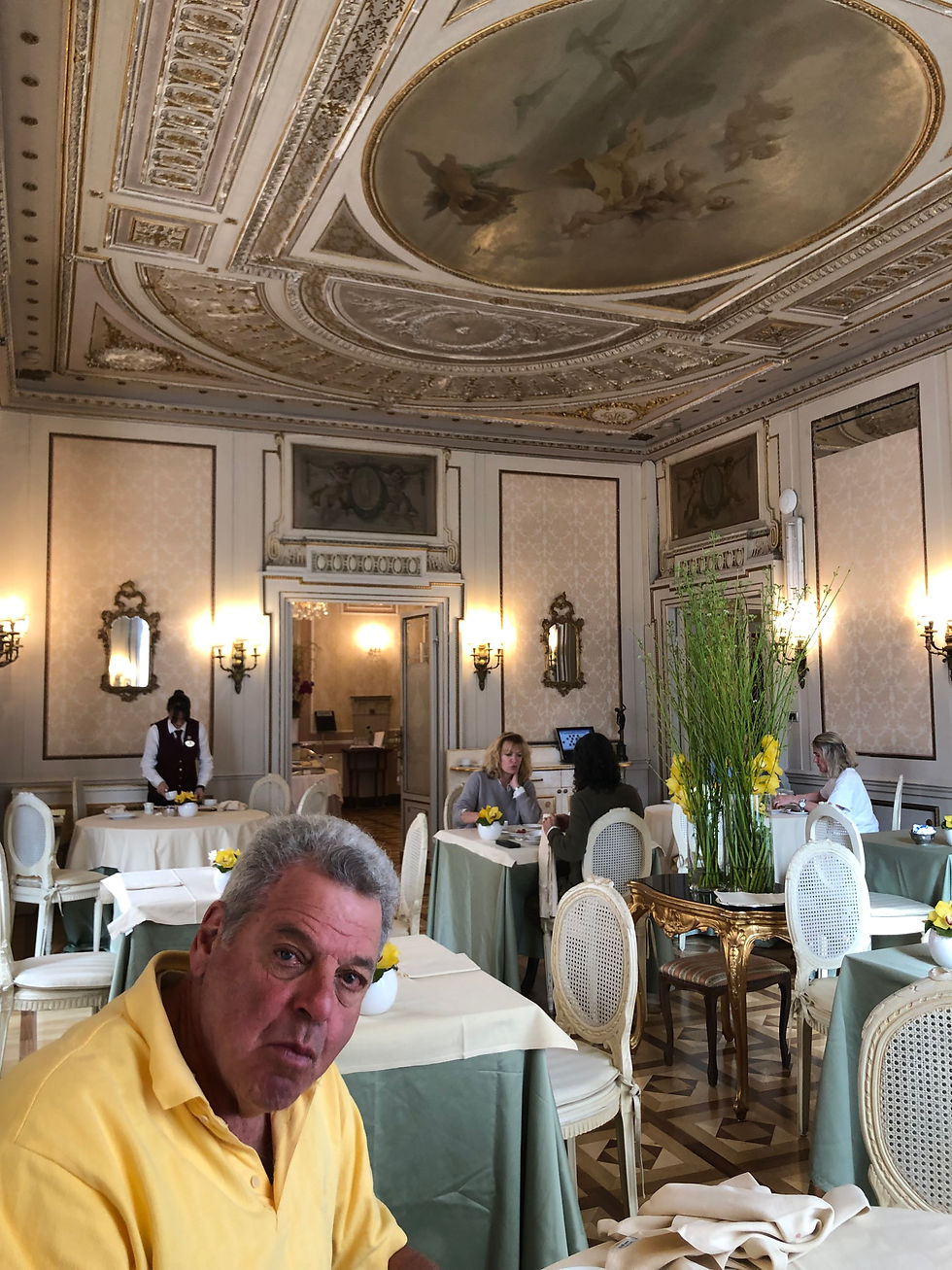
The hotel is linked to the name of Alfred Hitchcock, who was a frequent guest. According to a legend, he was inspired by the impressive elliptical staircase of this marble palace which then appeared in his film "Vertigo"

Via XX Settembre St. and the beautiful colorful mosaic floors of the Loggias
Restaurants
Via R. Gestro 9, 010 592764. 339 7956301. info @RistoranteIppogrifo.it
Very good classic Italian food
Ostetrattoroa
Via Alessando Rimassa 153 39 3403954901
Via di Porta Saprana 55/R +39 010 583534 +393451424449
Laconda Spinola - Pesce & Vini
Via della Scienza 17r 010 4077266 (in the historical old center)
+++++++++++++++++++++++++++++++++++++
Other tourist destination is the ancient seaside district of Boccadasse (which means "the mouth of the donkey"), with its fishing boats, set as the end of Corso Italia, (next post) and a promenade which runs along Corso Italia and known for its ice-creams.
Biscione Promanade Le Lavatrici
"Biscione", a development in the shape of a long snake, situated on the hills of the populous district of Marassi, and one of the social housing project known as "Le Lavatrici" -the washing machines.
After 5 full most enjoyable exploration days it was time to depart this fascinating town sunk in its glorious dreamy past, and move on...

To be Continued.......





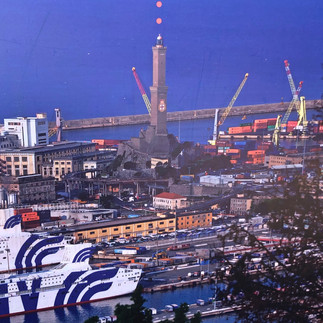


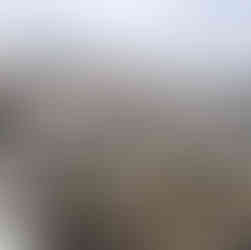







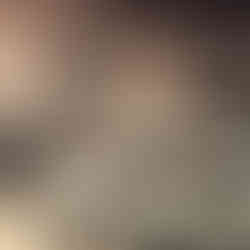












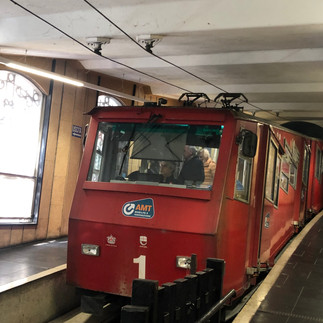



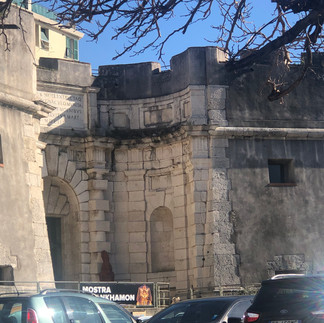


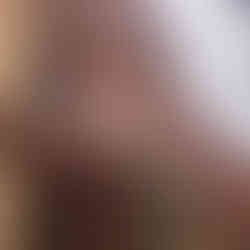





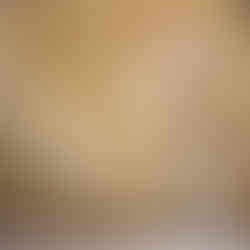




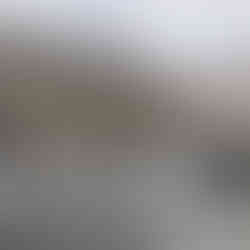



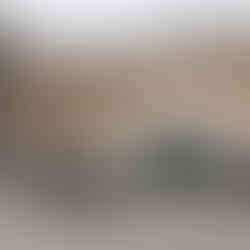


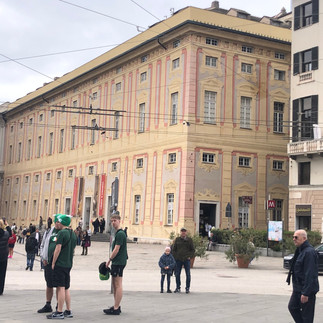



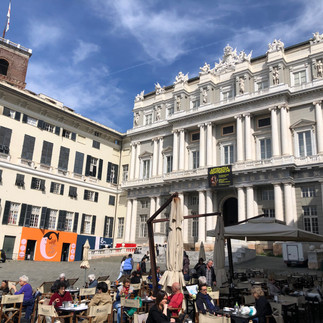








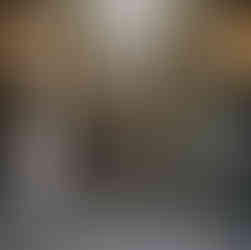








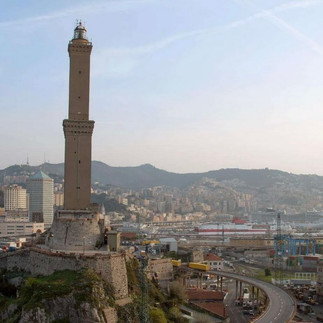
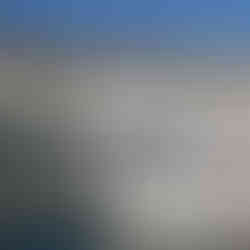

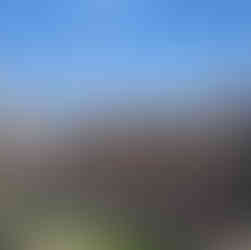


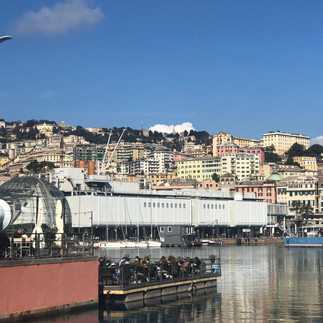














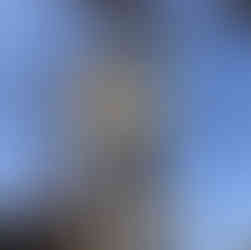

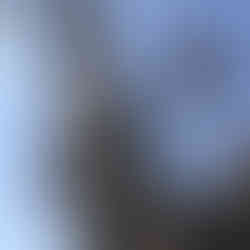

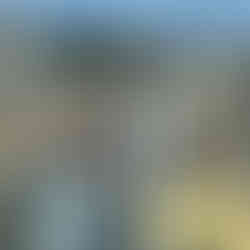



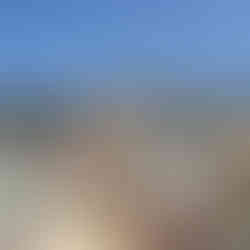















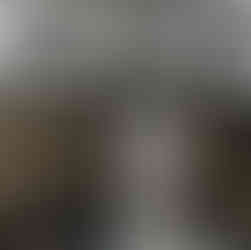

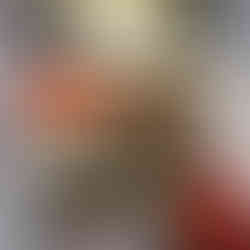



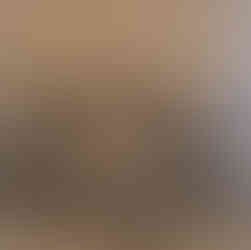










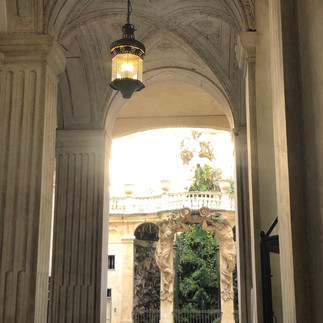
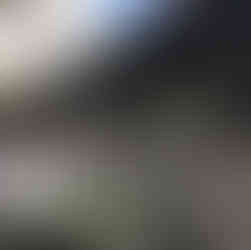

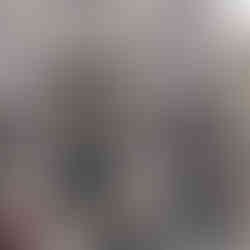















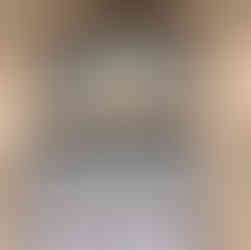



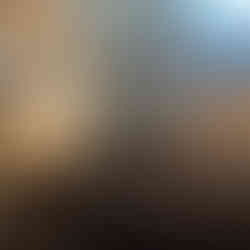





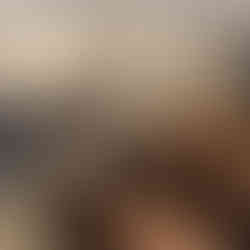






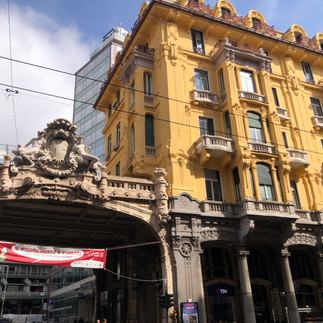


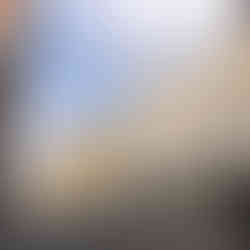


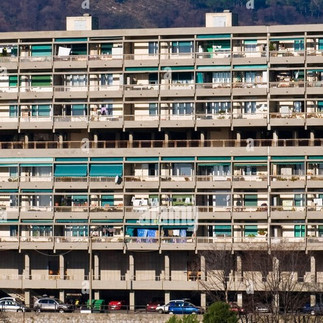
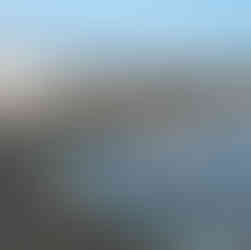



Comments